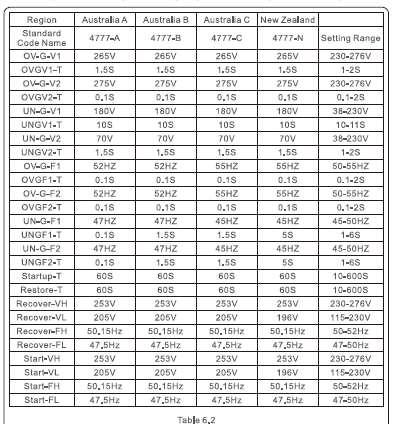I’ve been warned by the agents that this isn’t risk free…
Is there any way to deal with this risk??
Send it in to the agents?
These are the agents:
Hello Rich,
This is an old model that will possibly require a firmware update for those options to be available.
Even a Solis cloud doesn’t recognise this serial number anymore.
Since this unit is old, its very sensitive to firmware upgrade and there’s a possibility of the unit breaking during the firmware upgrade.
Kind Regards,
Lydia Madela
Service Line Operator and Support - South Africa
Address: 1487 Seilskip Road, Laser Park,
Honeydew, Roodepoort,
Gauteng
Office : +27 010 222 0181
National Service Line Number: +27871630747
I have a similar model. I set the grid code to New Zealand and that seems to do the trick when it is on the output of the Multi-RS. It has NRS097, but what I really wanted was the generator-50Hz profile, ie the microgrid one. It didn’t have it. I cannot be bothered to add it, it works well enough without it.
Thanks. I think the pragmatic way is the way to go…
Do you have a better manual than this one: Solis_Manual_(2,5-6)K_4G_ENX_V2,7
I have no manual at all… ![]()
Please clarify what is NRS097 and what its claim to fame is… (the agents also recommend this)
Also the other one
NRS097-2-1 is the South African grid code. The Solis has that as a setting. So if it’s just connected directly to your grid, then set that, and forget about it.
Many PV-inverters however have a “microgrid” setting, which you would use if that inverter is working together with another inverter (on the output of a Victron Multiplus for example), or with a diesel generator. This “grid code” is a bit more forgiving about frequency swings and voltage changes.
What I found is that the Solis inverters sold in SA will all have NRS097-2-1 as an option (you select it from the relevant menu), but not all of them have the microgrid gridcode.
I briefly considered updating the firmware on the Solis, because I have my Solis on the output of another inverter. But… I found that it also works just fine if I use the New Zealand grid code. So I did that, as a temporary thing… and it works well enough that I’m just not going to bother ![]()
This is exactly what I’m experiencing. (Hence the desire to upgrade)
Here is an Australian manual which has way more info in it than the std one: https://www.solisinverters.com.au/wp-content/uploads/2021/08/Solis_Manual_3-6K_4G_FN_AUS_V1.020210809.pdf
I presume the inverters are identical and are not made for different markets…
Yes! This setting is great because I don’t get the over frequency trips now.
The frequency control is quite slow however.
So when the system is idling the grid tie inverter drives up the battery inverter’s frequency which limits the current. Then when a load switches on the frequency slowly reduces allowing PV power to increase.
The other loop controlling the zero feed-in is a lot faster but also not easy to follow…
I’m not sure if I follow.
What I see on my PV-inverter, is when the batteries are full, the Multi-RS pushes the frequency up to 53Hz. This causes the Solis to shut down completely, with an over-frequency alarm. That is precisely what you want. Once a load starts (or the grid returns), the Solis inverter will follow the NZ grid code, which says it has to wait a certain amount of time, monitor that all parameters remain in bounds, and then it may reconnect. So there is always a bit of a delay on reconnection. For my use case, I don’t care about that so much.
Fronius inverters work similarly, on the MG50 grid code (microgrid 50Hz). You can go up to 52.7Hz, at which point power is reduced to zero, but the inverter does not shut down. It can ramp up very quickly once the frequency is lowered again. If you push the frequency to 53Hz, the inverter shuts down and there is a 2-minute delay before it reconnects.
The Multi, and the Multi-RS, uses this to ensure smooth reconnection to the grid. It will first push the frequency to 53Hz, causing the PV-inverter so shut down and go into a reconnect timeout. This gives the Multi enough time to match the grid frequency, and reconnect to the grid.
Without this delay, the PV-inverter would ramp power up quickly before the reconnection to the grid is complete, and potentially overcharge a battery.
Check the New Zealand limits. Their low voltage trip is a bit low. I wonder how they decided on this voltage…
I notice that the feed-in control loop does not reset. So if your inverter is being throttled due to the CT the integral component remains where it was providing a constant output.
Only if you cycle power to the inverter (AC & DC) does it reset…
Any suggestions??
No idea. I don’t use the current transformer. In fact, I plan on soon (for some value of soon) replacing the Solis with another Multi-RS, so I am not investing time into it unfortunately.
I have the same problem with my Solis-1P4.6K-4G. That is why I chose to have my whole system work in off grid mode. The CT I am only using if connected to grid to stop feeding back.
If you find a solution I would also be interested in it.
